Mycoplasma - Study guides, Class notes & Summaries
Looking for the best study guides, study notes and summaries about Mycoplasma? On this page you'll find 3052 study documents about Mycoplasma.
Page 4 out of 3.052 results
Sort by
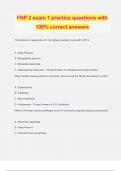
-
FNP 2 exam 1 practice questions with 100% correct answers
- Exam (elaborations) • 21 pages • 2024
-
- $12.49
- + learn more
FNP 2 exam 1 practice questions with 100% correct answers The bacterium responsible for the highest mortality in pts with CAP is: A. Strep Pneumo B. Mycoplasma pneumo C. Moraxella catarrhalis D. Haemophilus influenzae - Correct Answer ️️ -Streptococcus pneumoniae When initially treating adults for bronchitis, which would the NP be least likely to order? A. Expectorants B. Antibiotics C. Bronchodilators D. Antitussives - Correct Answer ️️ -B. Antibiotics What is the least comm...
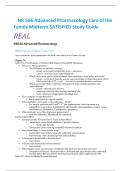
-
NR 566 Advanced Pharmacology Care of the Family Midterm SATISFIED Study Guide
- Exam (elaborations) • 34 pages • 2023
- Available in package deal
-
- $17.39
- 1x sold
- + learn more
NR 566 Advanced Pharmacology Care of the Family Midterm SATISFIED Study Guide REAL NR566 Advanced Pharmacology NR566 Week One PI Support: Chapter 70-76 -access medicine: with chamberlain- for flash cards and review of books for free Chapter 70 Table 70.1: Classifications of Antimicrobial Drugs by Susceptible Organisms: Narrow vs. Broad spectrum? o The Difference in antibiotic coverage ▪ broad: covers more and possibly gram – and gram + ▪ narrow: covers just a few microorgan...
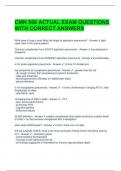
-
CMN 568 ACTUAL EXAM QUESTIONS WITH CORRECT ANSWERS
- Exam (elaborations) • 19 pages • 2024
- Available in package deal
-
- $13.49
- + learn more
CMN 568 ACTUAL EXAM QUESTIONS WITH CORRECT ANSWERS What area of lung is most likely the target of aspiration pneumonia? - Answer right upper lobe in the supine patient Common complication from ACUTE aspiration pneumonia - Answer lung abscess or empyema common complication from CHRONIC aspiration pneumonia - Answer bronchiectasis tx for acute aspiration pneumonia - Answer 1st line: IV clindamycin key symptoms of mycoplasma pneumonia - Answer - greater than 5yr old - dry coug...

-
OpenStax Microbiology - Test Bank Chapter 04: Prokaryotic Diversity.
- Exam (elaborations) • 18 pages • 2023
- Available in package deal
-
- $12.99
- 1x sold
- + learn more
OpenStax Microbiology - Test Bank Chapter 04: Prokaryotic Diversity. Chapter 4: Prokaryotic Diversity * = Correct answer Multiple Choice 1. Which is the best example of a population? A. all the microbes living in a particular area B. all the microbes of a particular domain living in a particular area C. all the microbes of a single species living in a particular area* D. all the microbes living within the same host Difficulty: Moderate ASM Standard: 20 2. Microbial ecology is defined...
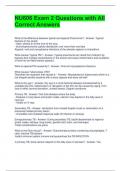
-
NU606 Exam 2 Questions with All Correct Answers
- Exam (elaborations) • 26 pages • 2024
- Available in package deal
-
- $12.99
- + learn more
NU606 Exam 2 Questions with All Correct Answers What is the difference between typical and atypical Pneumonia? - Answer- Typical: bacteria in the alveoli -lobar: affects an entire love of the lung -bronchopneumonia: patchy distribution over more than one lobe Atypical: viral and mycoplasma infections of the alveolar septum or interstitium What causes Typical PN? - Answer- Typical pneumonia can result from infection by bacteria that multiply extracellularly in the alveoli and cause i...
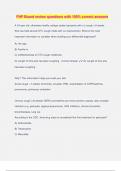
-
FNP Board review questions with 100% correct answers
- Exam (elaborations) • 131 pages • 2024
-
- $13.49
- + learn more
FNP Board review questions with 100% correct answers A 24-year old, otherwise healthy college student presents with c/o cough x 6 weeks. She has tried several OTC cough meds with no improvement. What is the most important information to consider when building your differential diagnoses? A) Her age B) Family hx C) Ineffectiveness of OTC cough medicines D) Length of time she has been coughing - Correct Answer ️️ -D) Length of time she has been coughing Why? This information helps you...

-
LAT Final Exam; Questions with Complete Solutions
- Exam (elaborations) • 52 pages • 2024
-
- $23.99
- + learn more
LAT Final Exam; Questions with Complete Solutions What infectious agent is the cause of "snuffles" in rabbits? a) Mycoplasma pulmonis b) Sendai virus c) Bordetella bronchiseptica d) Pasteurella multocida Correct answer-D Which of the following is not one of the major clinical signs of inflammation? a) Heat b) Analgesia c) Redness d) Pain Correct answer-B
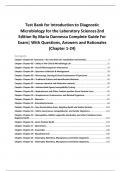
-
Test Bank for Introduction to Diagnostic Microbiology for the Laboratory Sciences 2nd Edition By Maria Dannessa Complete Guide For Exam| With Questions, Answers and Rationales (Chapter 1-24)
- Exam (elaborations) • 223 pages • 2024
-
- $17.99
- + learn more
Chapter: Chapter 20 - Chlamydia, Rickettsia, Mycoplasma and Similar Organisms Fill In the Blank 1. In the life cycle of chlamydia, the __________ is the infective particle that attaches to the host cells. Ans: elementary body Complexity: easy Ahead: Chlamydiaceae Subject: Chapter 20 Title: Chlamydia, Rickettsia, Mycoplasma and Similar Organisms
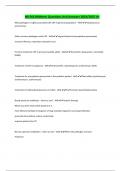
-
NR 566 Midterm Questions And Answers 2024/2025 A+
- Exam (elaborations) • 13 pages • 2024
-
- $13.49
- + learn more
NR 566 Midterm Questions And Answers 2024/2025 A+ What pathogen is highly associated with CAP in general population? - ANS-streptococcus pneumoniae Other common pathogens with CAP - ANS-atypical bacteria (mycoplasma pneumonia) viruses (influenza, respiratory syncytial virus) First line treatment CAP in previous healthy adults - ANS-Amoxicillin, doxycycline, macrolides (DAM) Treatment of CAP in pregnancy - ANS-amoxicillin, cephalosporins, erythromycin (ACE) Treatment for mycoplasma pneu...
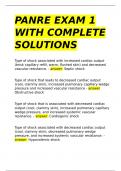
-
PANRE EXAM 1 WITH COMPLETE SOLUTIONS
- Exam (elaborations) • 34 pages • 2024
-
- $13.49
- + learn more
Type of shock associated with increased cardiac output (brisk capillary refill, warm, flushed skin) and decreased vascular resistance. Septic shock Type of shock that leads to decreased cardiac output (cool, clammy skin), increased pulmonary capillary wedge pressure and increased vascular resistance Obstructive shock Brainpower Read More Type of shock that is associated with decreased cardiac output (cool, clammy skin), increased pulmonary capillary wedge pressure, and increa...

That summary you just bought made someone very happy. Also get paid weekly? Sell your study resources on Stuvia! Discover all about earning on Stuvia


